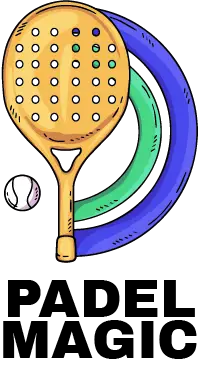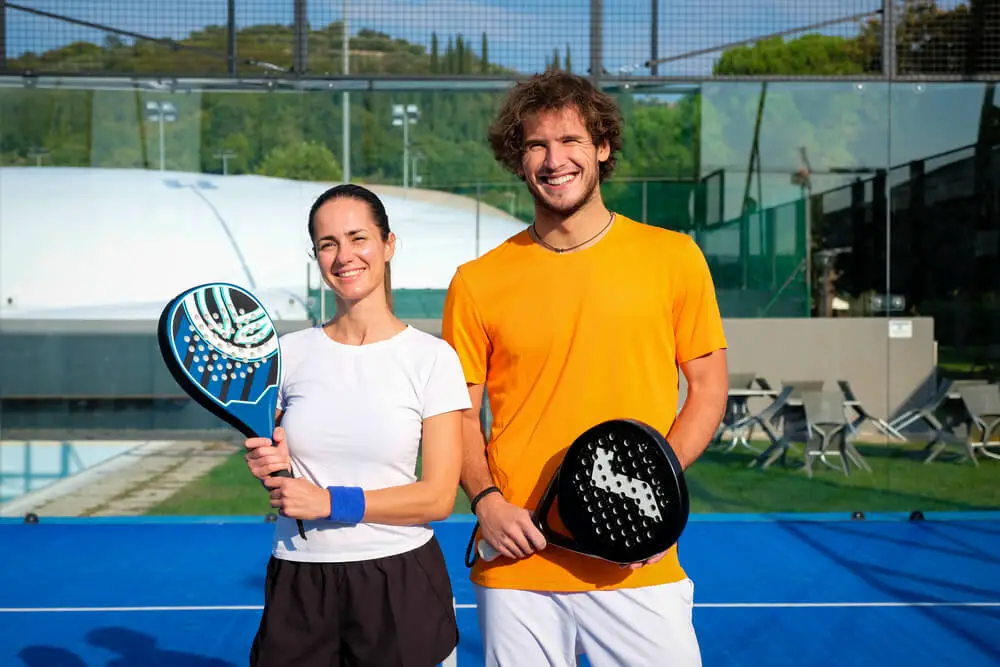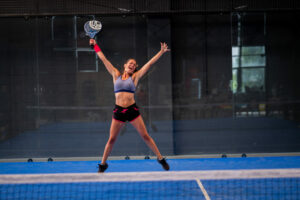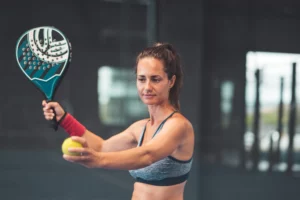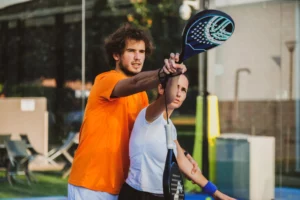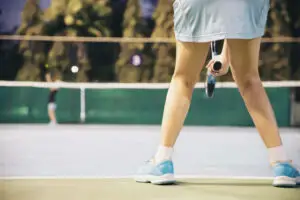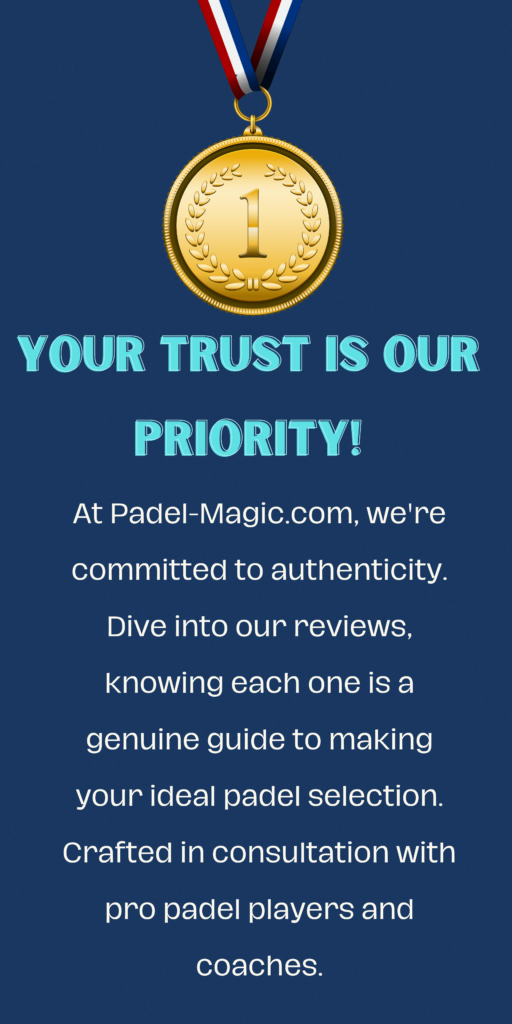Fundamental Strokes in Padel to Enhance Your Game
Looking to elevate your padel skills and add versatility to your game? Mastering a variety of strokes is critical to becoming a well-rounded player, capable of both aggressive attacks and solid defense.
This article is your guide to understanding and practicing 10 fundamental padel strokes. When practiced and perfected, these techniques can significantly enhance your performance on the court. So, grab your racket, and let’s explore these essential strokes that could give you an edge in your next padel match.
To understand how these strokes fit into the broader game, read more about What Is Padel?
Padel Serve
In Padel, the serve sets the stage for the game. While players have two chances to serve, effectively utilizing the first serve is key to maintaining the game’s tempo and control. A well-thought-out serve, often aimed towards the side wall and at a speed that suits the player’s strategy, allows them to swiftly move into a net position and gain an early advantage in the rally. This approach to serving can be a crucial factor in dictating the pace and direction of the point.
Forehand and Backhand Basics
Mastering the forehand and backhand shots in padel, especially those played without the assistance of the wall, is crucial for newcomers and seasoned players alike. These fundamental strokes are pivotal in sustaining the rally and strategically placing the ball. Aim to direct these shots diagonally across the court. This approach not only feels more natural but also leverages the court’s length, enhancing the likelihood of the ball landing in challenging positions for your opponent.
If you’re new to Padel, gain a solid foundation by exploring Padel For Beginners.
The Art of Off-the-Wall Shots
The art of playing shots off the wall lies at the heart of Padel, setting it apart from other racket sports. This unique aspect brings dynamic play and offers players a chance for recovery and continuation of play, adding an element of excitement to the game. When playing wall shots, the decision to adopt an offensive or defensive stance depends on various factors, like the wall’s rebound height and distance from the player. Always remember, playing from the back of the court not only allows for strategic positioning but also helps in deciding when to advance towards the net. Even when aiming for an aggressive shot, it’s wise to maintain a margin for error to keep the upper hand in the rally.
Dominating with the Smash
The smash is padel’s most powerful shot, often used to conclude a point decisively. However, it requires precision; a poorly executed smash can give your opponent an opening to return to the rally. The key is to hit the ball while it’s still high and bring your racket down sharply over it.
La Chiquita: The Subtle Art
La Chiquita, characterized by its gentler, less forceful approach, aims to draw the opponent into a lower position than the net height. It’s particularly effective when your opponent is aggressively playing at the net, allowing you to push them back and regain control of the rally. Precision in shot placement is the key to its effectiveness.
Utilizing the Back Glass
This is your go-to option for responding to lobs that you can’t directly attack. It’s fundamentally a defensive stroke that buys you time to plan your next move. Mastering the back glass shot can be challenging, but once you do, it can frustrate your opponent and compel them to take more risks.
Mastering the Lob
The lob is a vital defensive tool in padel, offering a strategic edge to players. It’s an excellent way to set up a counterattack, gain a favorable net position, and put the adversary under pressure. Mastering the lob can significantly shift the balance of a match in your favor.
To ensure you’re using the lob according to official rules, check out our detailed guide on Padel Rules.
The Power of the Volley
As one of Padel’s most aggressive shots, the volley is crucial for scoring points, disrupting your opponents’ defense, and creating instability in their gameplay. Playing volleys at the net significantly increases your chances of winning. It’s a crowd-pleaser too, known for its powerful execution and strategic placement.
La Bandeja: Balancing Attack and Defense
The bandeja is a nuanced shot that floats between offensive and defensive play. It’s a challenging stroke but mastering it allows you to advance and maintain your attack at the net, pushing your opponent to fall back and defend.
The Vibora: A Tactical Mix
The Vibora is a blend of a smash and the bandeja, used to either finish a point or to pressure opponents, depending on where it’s played on the court. It’s particularly useful for those who may not have a powerful smash but want to outmaneuver their opponents strategically.
Drills and Exercises
Forehand and Backhand Drills
- Consistency Drill: Pair up with a partner and rally, aiming to hit 20 consecutive forehands and then 20 backhands without errors. This helps in improving your consistency and control.
- Target Practice: Set up targets in different areas of the court. Practice hitting forehands and backhands aiming for these targets to improve accuracy.
Lob Drills
- Lob Over Obstacle: Set a physical barrier (like a net or a rope) at the net’s height. Practice hitting lobs over the obstacle from the baseline. This helps in mastering the lob’s height and depth.
- Defensive to Offensive Transition: Practice transitioning from a defensive lob to an offensive position. After hitting a lob, quickly move forward to prepare for a volley or smash.
Volley Drills
- Rapid-Fire Volleys: Have a coach or partner feed you quick volleys at the net. Focus on quick reactions and placing your volleys accurately.
- Volley to Volley Exchange: Engage in a volley exchange with a partner, focusing on control and placement rather than power.
Common Mistakes and Corrections
Forehand and Backhand Mistakes
- Mistake: Overhitting or using too much wrist.
- Correction: Focus on using your core and shoulders for power, keeping the wrist firm for control.
Lob Mistakes
- Mistake: Hitting the lob too short makes it easy for the opponent to smash.
- Correction: Practice giving enough height and depth to the lob, aiming for the back third of the court.
Volley Mistakes
- Mistake: Dropping the racket head below the net level, leading to a lack of control and power.
- Correction: Keep the racket head up and use a short, controlled swing for volleys.
These drills and corrections are designed to tackle specific areas of improvement and help players develop a more refined and effective padel game. Remember, practice and consistency are key to mastering these techniques.
Personalized Tips for Padel Strokes at Different Skill Levels
Beginner Level:
- Focus on the Basics: Start with mastering the forehand and backhand strokes without wall assistance.
- Practice Drill: Engage in consistent rallies, focusing on control and accuracy of the forehand and backhand.
- Common Mistake: Overusing wrist action.
- Correction: Use your core and shoulders for power, ensuring a firm wrist for better control.
Intermediate Level:
- Developing Skills: Work on improving the lob and back glass shots.
- Practice Drill: Perform lobs over a net at varying heights and distances to refine depth control. Practice back glass shots to respond effectively to challenging lobs.
- Common Mistake: Hitting lobs too short, making them easy for opponents to attack.
- Correction: Focus on giving your lobs enough height and depth, aiming for the back third of the court.
Advanced Level:
- Advanced Techniques: Focus on mastering aggressive shots like the smash and volley.
- Practice Drill: Practice smashes and volleys with a focus on power and placement. Engage in drills that improve reaction time and precision at the net.
- Common Mistake: Poor execution of the smash, leading to loss of point opportunity.
- Correction: Hit the smash while the ball is high, bringing the racket down over the ball with controlled power.
